8 Oct 2020 at 4 pm
School of Music Building, UBC
Soundings: Raven Chacon and Symphonic Wind Ensemble
-
Raven Chacon
ArtistRaven Chacon is a composer, performer and installation artist from Fort Defiance, Navajo Nation whose practice centers in sound. Chacon is one of the three members of the interdisciplinary arts collective Post-commodity, along with Cristobal Martínez and Kade L. Twist. As a solo artist and in collaborations, Chacon has exhibited or performed at Whitney Biennial, documenta 14, REDCAT, Musée d’art Contemporain de Montréal, San Francisco Electronic Music Festival, Chaco Canyon, Ende Tymes Festival, 18th Biennale of Sydney, and The Kennedy Center. Every year, he teaches 20 students to write string quartets for the Native American Composer Apprenticeship Project (NACAP). He is the recipient of the United States Artists fellowship in Music, The Creative Capital award in Visual Arts, The Native Arts and Cultures Foundation artist fellowship, and the American Academy’s Berlin Prize for Music Composition. He lives in Albuquerque, New Mexico, and Toronto, ON.
Read More
-
Robert Taylor
Musician and DirectorRobert Taylor is Professor of Music and Director of Bands at the University of British Columbia, where he conducts the Symphonic Wind Ensemble, teaches graduate and undergraduate conducting and serves as Chair of the Woodwind Brass and Percussion Division. With a career in music education spanning over twenty-five years, previous appointments include the University of Puget Sound in the state of Washington and Eureka High School in northern California, where ensembles under his direction earned recognition by Downbeat Magazine, the Selmer Corporation and Grammy Signature Schools.
Read More
-
Symphonic Wind Ensemble
MusiciansLed by Robert Taylor, the Symphonic Wind Ensemble is comprised of the wind and percussion students in the UBC School of Music and is dedicated to the performance of the finest wind repertoire, regardless of the period or size of ensemble and is distinguished by its high-level of performance, creative thematic programming and commitment to contemporary music through commissions, premieres and composer residencies. The performers at this concert included Renz Adame (oboe), Erica Binder (trumpet), Henry Cao (alto saxophone), Madeleine Davis (horn), Jesse Guo (percussion), Kristiāns Jautaiķis (percussion), Yuri Kuriyama (clarinet), Sam Paige (tuba), Allan Perpose Jr. (percussion), Emily Richardson (flute), Emmanuel Rihl (baritone saxophone), Kristofer Siy (percussion), Gage Sippel (tuba), Dana Sullivan (trombone), Hanna Van Inwegen (horn), Siliang Wang (flute), Katelynn Whittle (oboe), Allan Xu (tenor saxophone), Mo Yan (clarinet) and Anican Yu (melodica), with Jay Pahre as the woodchopper.
Read More
Raven Chacon
American Ledger (No. 1), 2018
polyester banner
Collection of the artist
Around the corner from the Belkin Gallery, Raven Chacon’s score American Ledger (No. 1) hangs on the exterior of the Music Building at 6361 Memorial Road, UBC. The conceptual graphic score is to be performed by “many players with sustaining and percussive instruments, voices, coins, axe and wood, a police whistle and the striking of a match.” Chacon invites any number of musicians with any number of non-musicians to perform the piece; instructions for performers can be found on the exterior of the Music Building as well as below and all are encouraged to perform the score.
For many players with sustaining and percussive instruments, voices, coins, axe and wood, a police whistle, and a match.
For at least 13 minutes.
For any number of musicians with any number of non-musicians.
Each line is a minute or longer.
Line 1 is for both percussive and bendable tones.
Line 2 begins with a warbly long tone crossfading into waves of harmonic or dynamic increases. X = chop wood.
Line 3 is for police whistle(s). Other instruments may join.
Line 4 is for coins to be thrown. Two instruments may accompany.
Line 5 is a line.
Line 6 is a grand decelerando ending with the striking of a match.
Line 7 is for acknowledging groupings of 5’s and 4’s. Chop wood. End with everyone and everything.
On Thursday, 8 October 2020 at 4 pm, UBC School of Music’s Symphonic Wind Ensemble performs Chacon’s score outside the Music Building, in front of Gerhard Class’s 1968 Tuning Fork sculpture. Led by Robert Taylor, the Symphonic Wind Ensemble is comprised of the wind and percussion students in the School of Music and is dedicated to the performance of the finest wind repertoire, regardless of the period or size of ensemble and is distinguished by its high-level of performance, creative thematic programming and commitment to contemporary music through commissions, premieres and composer residencies.
Online from Friday 20 November 2020, the Chan Centre in collaboration with the UBC School of Music and the Belkin presents The Music of Raven Chacon as part of their Dot Com Series. This virtual concert includes digital recordings of three of Chacon’s compositions: American Ledger performed by the UBC Symphonic Wind Ensemble led by Robert Taylor; La’ts’aadah performed by violist Marina Thibeault; and Horse Notations performed by Paolo Bortolussi (flute), Jasper Wood and David Gillham (violins), Marina Thibeault (viola), Eric Wilson (cello) and Russell Wallace (drum).
Raven Chacon’s work is part of Soundings: An Exhibition in Five Parts at the Morris and Helen Belkin Art Gallery (September 8-December 6, 2020).
Photos: Rachel Topham Photography
Video: Aya Garcia
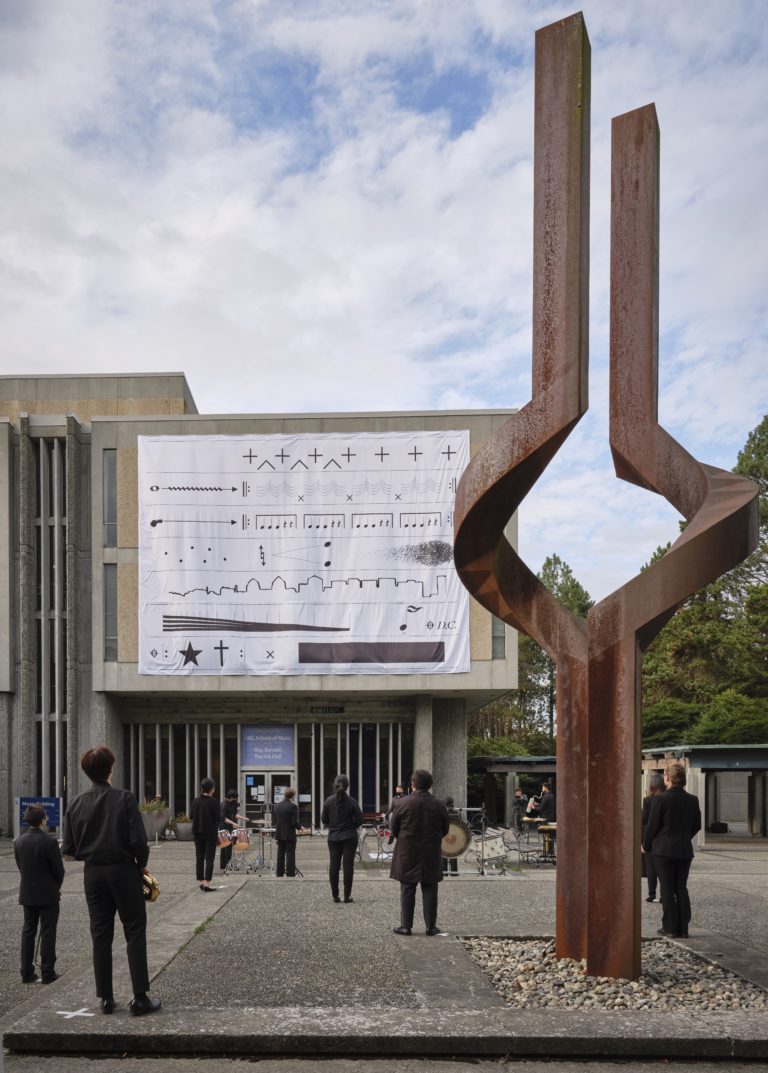
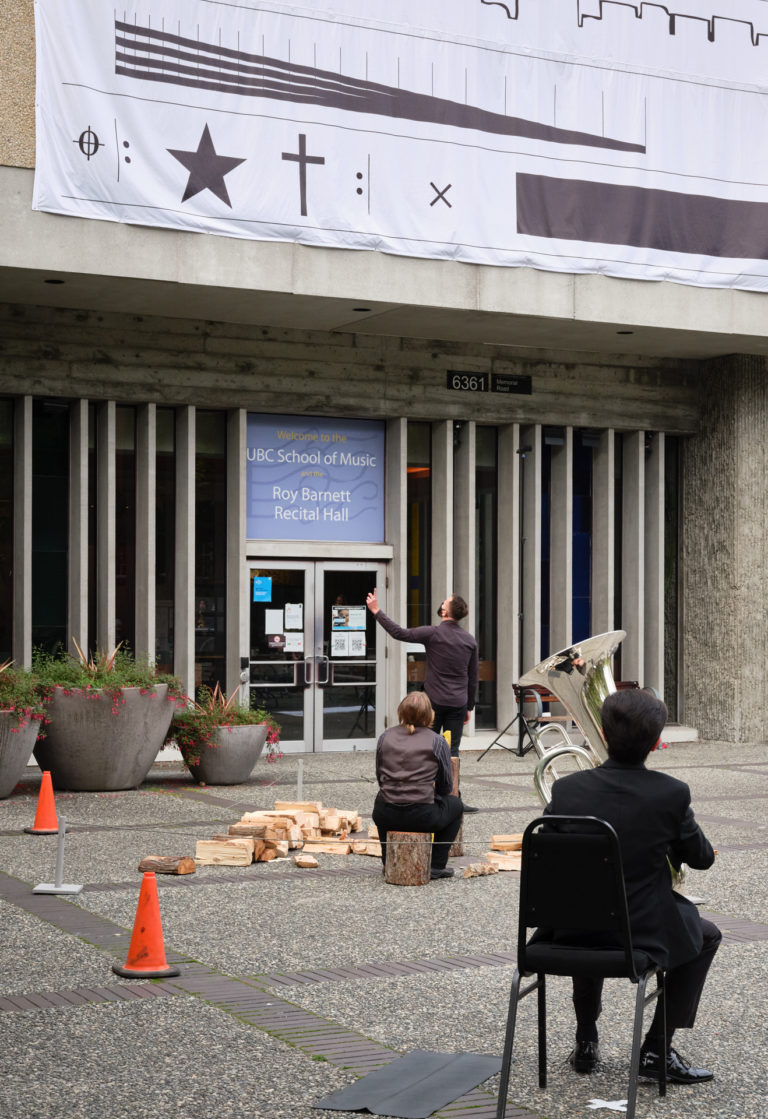
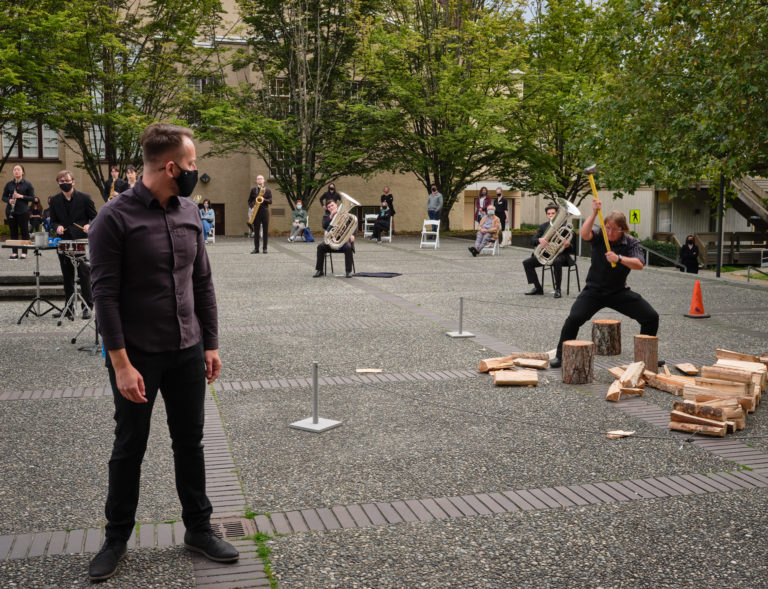
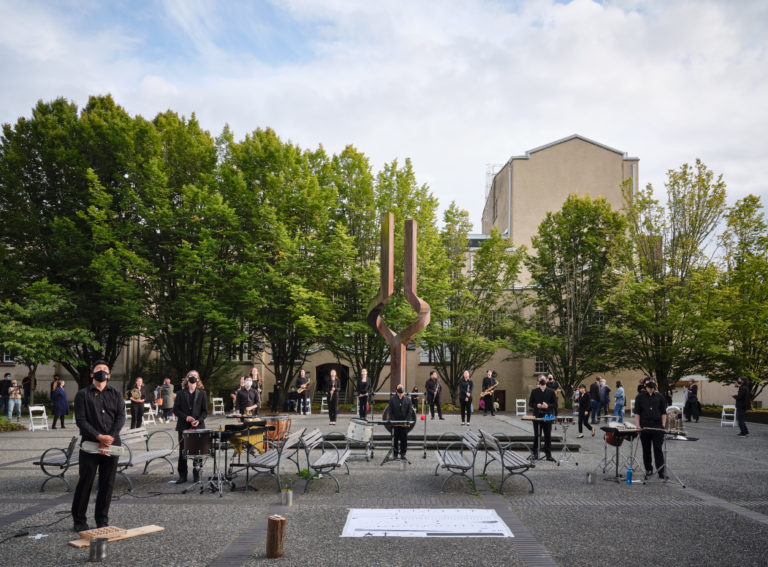
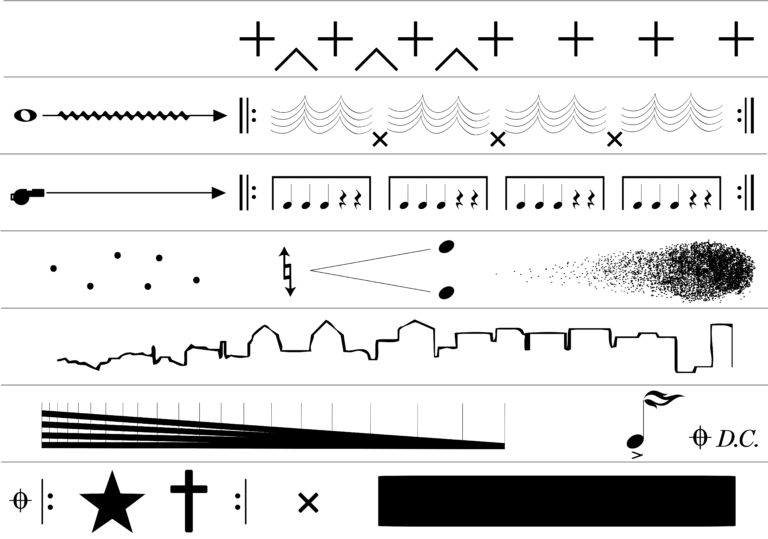
-
Raven Chacon
ArtistRaven Chacon is a composer, performer and installation artist from Fort Defiance, Navajo Nation whose practice centers in sound. Chacon is one of the three members of the interdisciplinary arts collective Post-commodity, along with Cristobal Martínez and Kade L. Twist. As a solo artist and in collaborations, Chacon has exhibited or performed at Whitney Biennial, documenta 14, REDCAT, Musée d’art Contemporain de Montréal, San Francisco Electronic Music Festival, Chaco Canyon, Ende Tymes Festival, 18th Biennale of Sydney, and The Kennedy Center. Every year, he teaches 20 students to write string quartets for the Native American Composer Apprenticeship Project (NACAP). He is the recipient of the United States Artists fellowship in Music, The Creative Capital award in Visual Arts, The Native Arts and Cultures Foundation artist fellowship, and the American Academy’s Berlin Prize for Music Composition. He lives in Albuquerque, New Mexico, and Toronto, ON.
Read More
-
Robert Taylor
Musician and DirectorRobert Taylor is Professor of Music and Director of Bands at the University of British Columbia, where he conducts the Symphonic Wind Ensemble, teaches graduate and undergraduate conducting and serves as Chair of the Woodwind Brass and Percussion Division. With a career in music education spanning over twenty-five years, previous appointments include the University of Puget Sound in the state of Washington and Eureka High School in northern California, where ensembles under his direction earned recognition by Downbeat Magazine, the Selmer Corporation and Grammy Signature Schools.
Read More
-
Symphonic Wind Ensemble
MusiciansLed by Robert Taylor, the Symphonic Wind Ensemble is comprised of the wind and percussion students in the UBC School of Music and is dedicated to the performance of the finest wind repertoire, regardless of the period or size of ensemble and is distinguished by its high-level of performance, creative thematic programming and commitment to contemporary music through commissions, premieres and composer residencies. The performers at this concert included Renz Adame (oboe), Erica Binder (trumpet), Henry Cao (alto saxophone), Madeleine Davis (horn), Jesse Guo (percussion), Kristiāns Jautaiķis (percussion), Yuri Kuriyama (clarinet), Sam Paige (tuba), Allan Perpose Jr. (percussion), Emily Richardson (flute), Emmanuel Rihl (baritone saxophone), Kristofer Siy (percussion), Gage Sippel (tuba), Dana Sullivan (trombone), Hanna Van Inwegen (horn), Siliang Wang (flute), Katelynn Whittle (oboe), Allan Xu (tenor saxophone), Mo Yan (clarinet) and Anican Yu (melodica), with Jay Pahre as the woodchopper.
Read More
Related
-
Event
10 Sep 2020
Soundings: Diamond Point and Coastal Wolf Pack
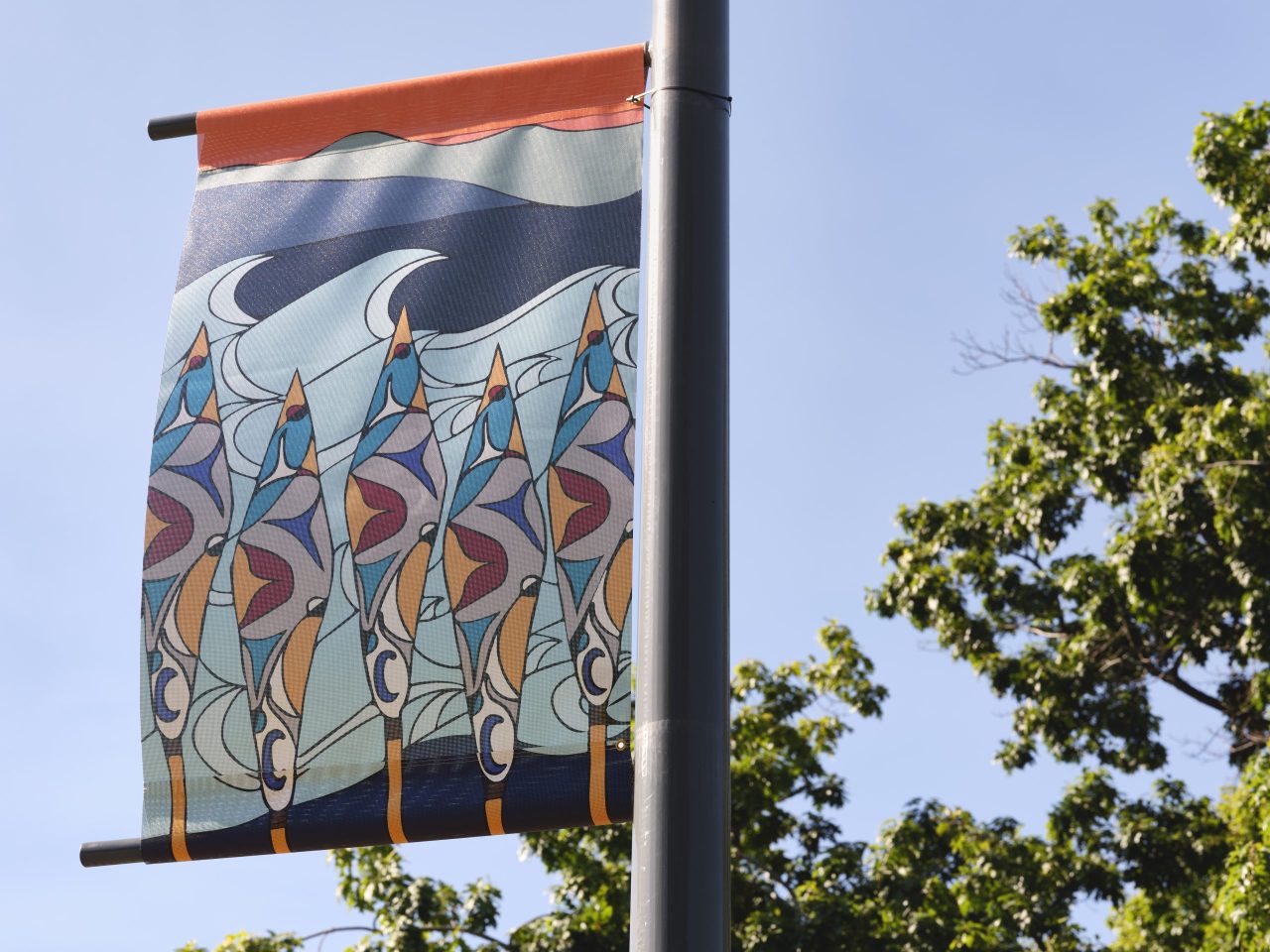
Forming two continuous lines on this part of the traditional, ancestral and unceded territory of the xʷməθkʷəy̓əm (Musqueam) people, wəɬ m̓i ct q̓pəθət tə ɬniməɬ by Diamond Point presents two images repeating in a sequence hung on the lampposts along UBC’s Main Mall from James Hart’s Reconciliation Pole to the plaza just beyond the Belkin.
[more] -
Event
Soundings: Germaine Koh
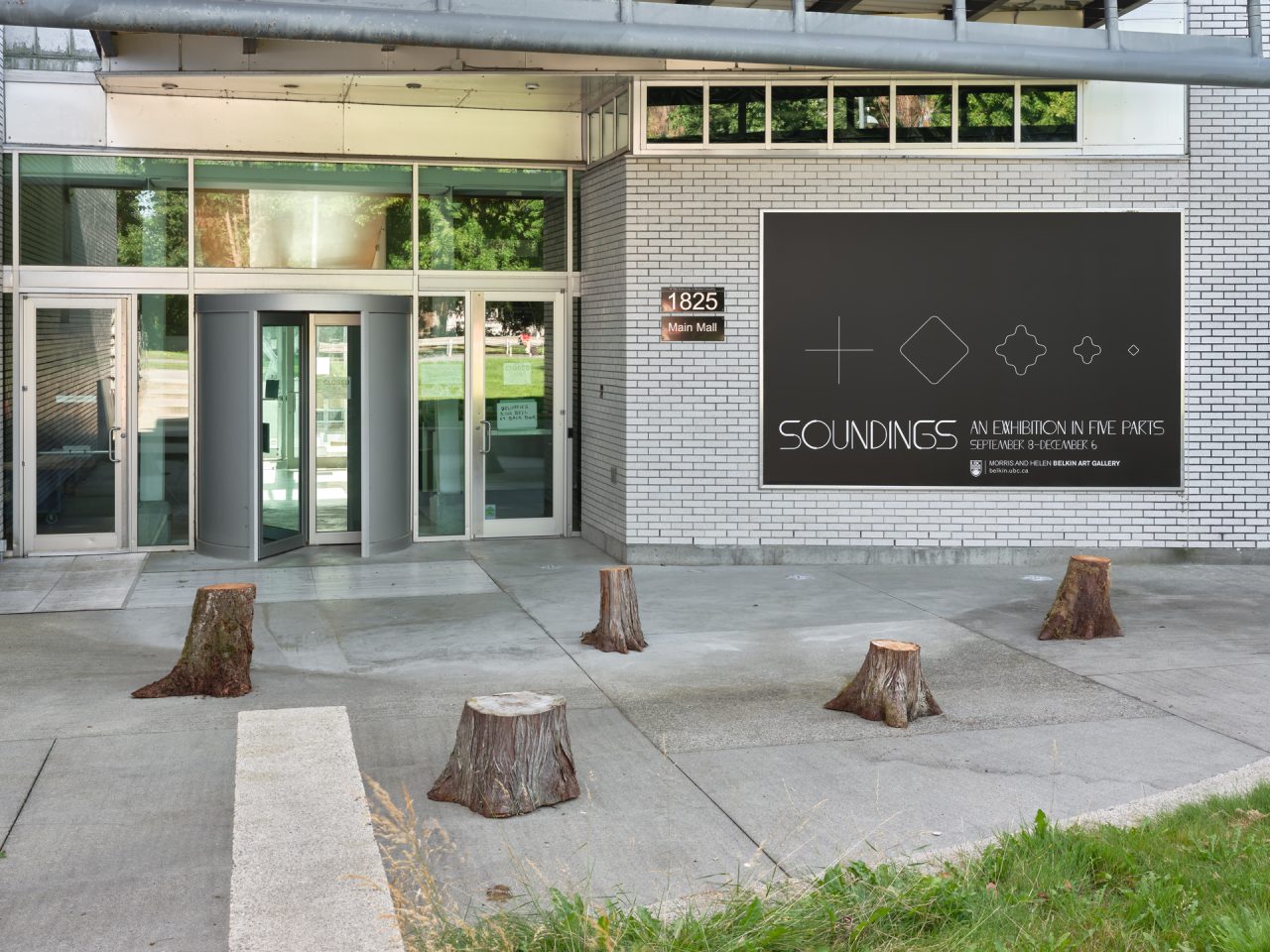
Germaine Koh’s drum is made from one of the cedar tree stumps she first brought to site for use as physical distancing stations. She worked with Belkin staff during Summer 2020 to develop COVID-19 safety and visitor interaction protocols that recognized the importance of collective care and teamwork.
[more] -
Event
8 Sep 2020
Soundings: Peter Morin and Parmela Attariwala
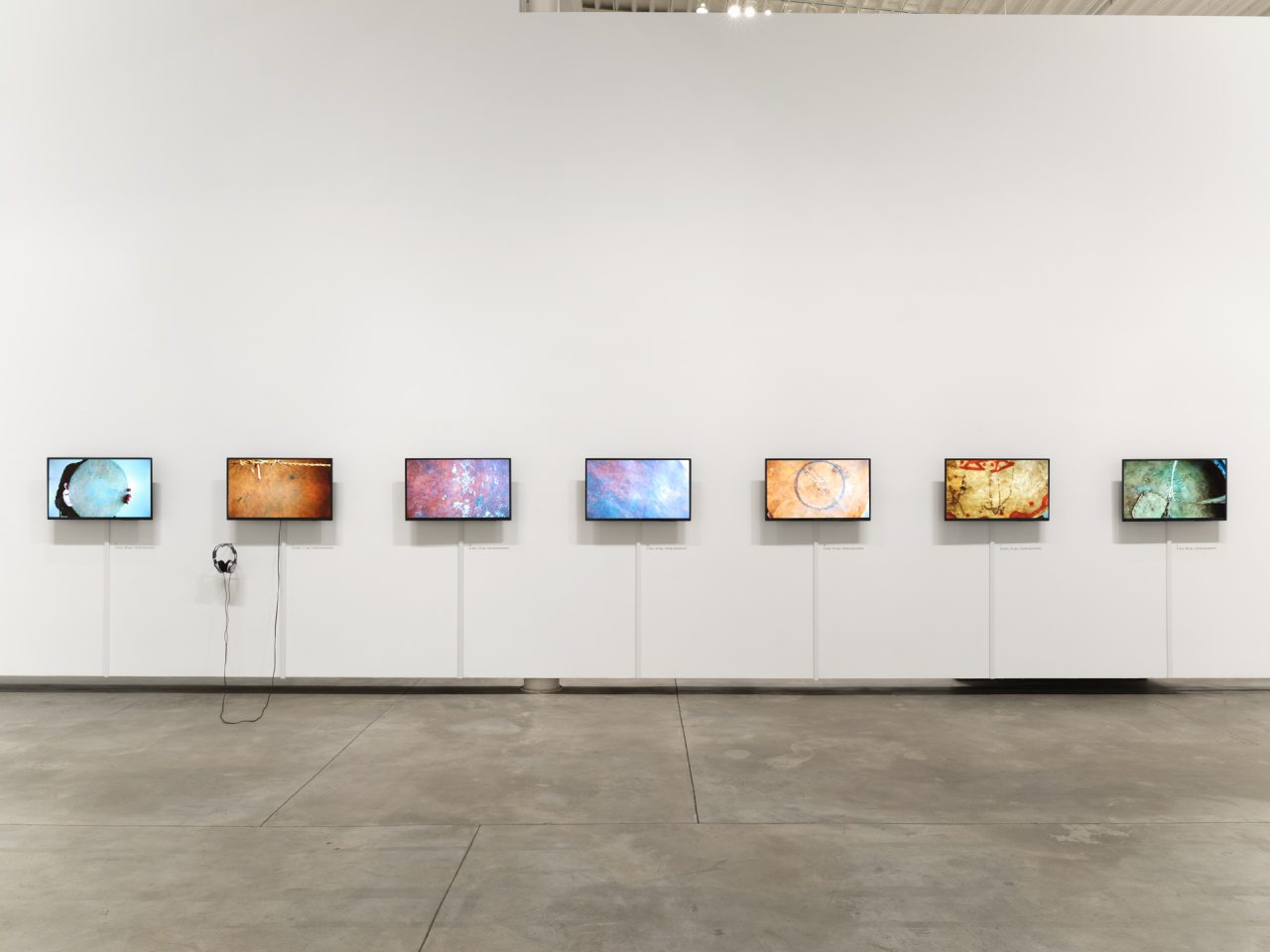
In Part One of NDN Love Songs, Peter Morin offers a score of instructions to musicians presented alongside seven video portraits. Part Two presents videos of recordings of previous iterations of the Soundings exhibition at Agnes Etherington Art Centre, Gund Gallery and Kitchener-Waterloo Art Gallery. In Part Three, Parmela Attariwala performs the score on the violin at the Belkin.
[more] -
Exhibition
8 Sep – 6 Dec 2020
Soundings: An Exhibition in Five Parts
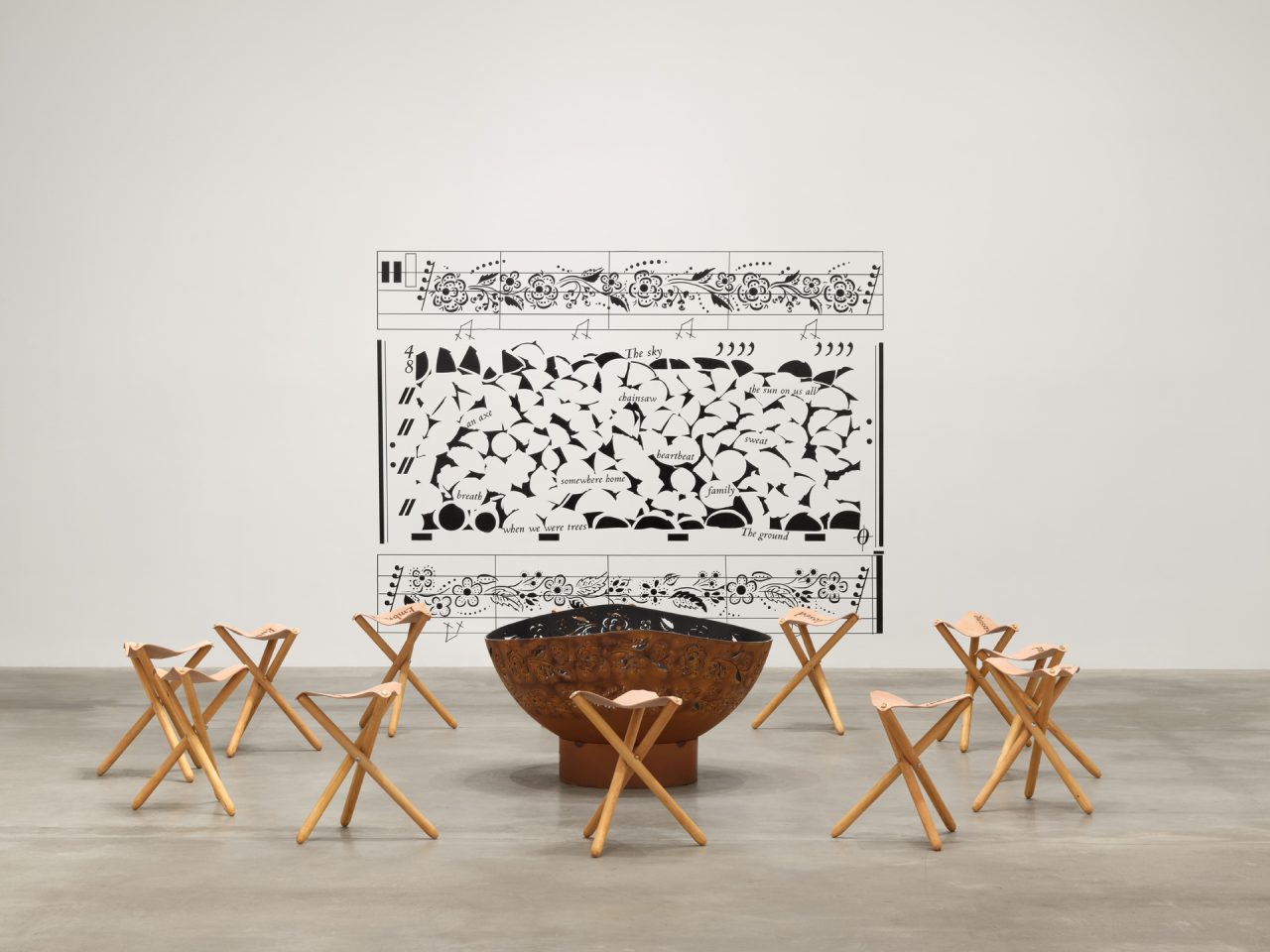
Soundings: An Exhibition in Five Parts features newly commissioned scores, performances, videos, sculptures and sound by Indigenous and other artists who respond to the question, How can a score be a call and tool for decolonization? Unfolding in a sequence of five parts, the scores take the form of beadwork, videos, objects, graphic notation, historical belongings and written instructions. During the exhibition, these scores are activated at specific moments by musicians, dancers, performers and members of the public, gradually filling the gallery and surrounding public spaces with sound and action. Curated by Candice Hopkins and Dylan Robinson, Soundings is cumulative, limning an ever-changing community of artworks, shared experience and engagement. Shifting and evolving, it gains new artists and players in each location. For this iteration on Musqueam territory, the Belkin has collaborated with UBC's Musqueam Language Program in partnership with the Musqueam Indian Band Language and Culture Department; School of Music; Chan Centre for Performing Arts; First Nations House of Learning and Museum of Anthropology to support the production of new artworks and performances by local artists.
[more] -
News
31 Aug 2020
Soundings: Reading Room
The following is a list of resources related to Soundings: An Exhibition in Five Parts. The list of resources compiled here is not an official recommendation, but is rather a list of suggested readings compiled by Public Programs and graduate student researchers at the Belkin Art Gallery. These readings are intended to provide additional context for the exhibition and act as springboards for further research or questions stemming from the exhibition, artists, and works involved.
[more] -
News
30 Nov 2020
Belkin x CRWR: Soundings
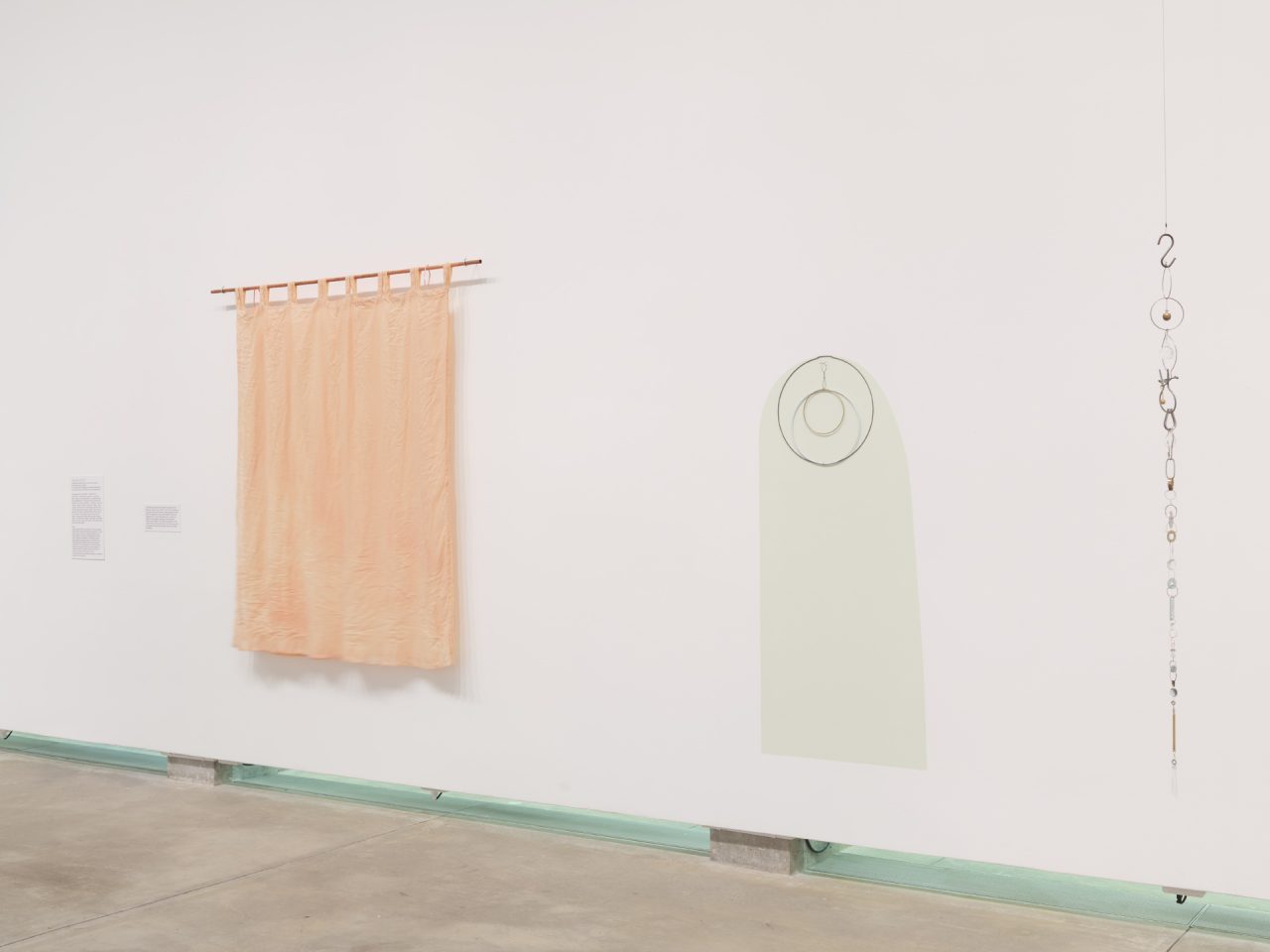
In response to Soundings: An Exhibition in Five Parts, a group of Creative Writing graduate students at the University of British Columbia have made a series of activities for visitors to take part in during their visits to the gallery. Thinking through the idea of a score as a call to respond, these activities range from sound walks to reflective worksheets to small group workshops.
[more] -
Event
Sunday 8 Nov 2020 at 3 pm
Soundings: Camille Georgeson-Usher and Rachel Kiyo Iwaasa
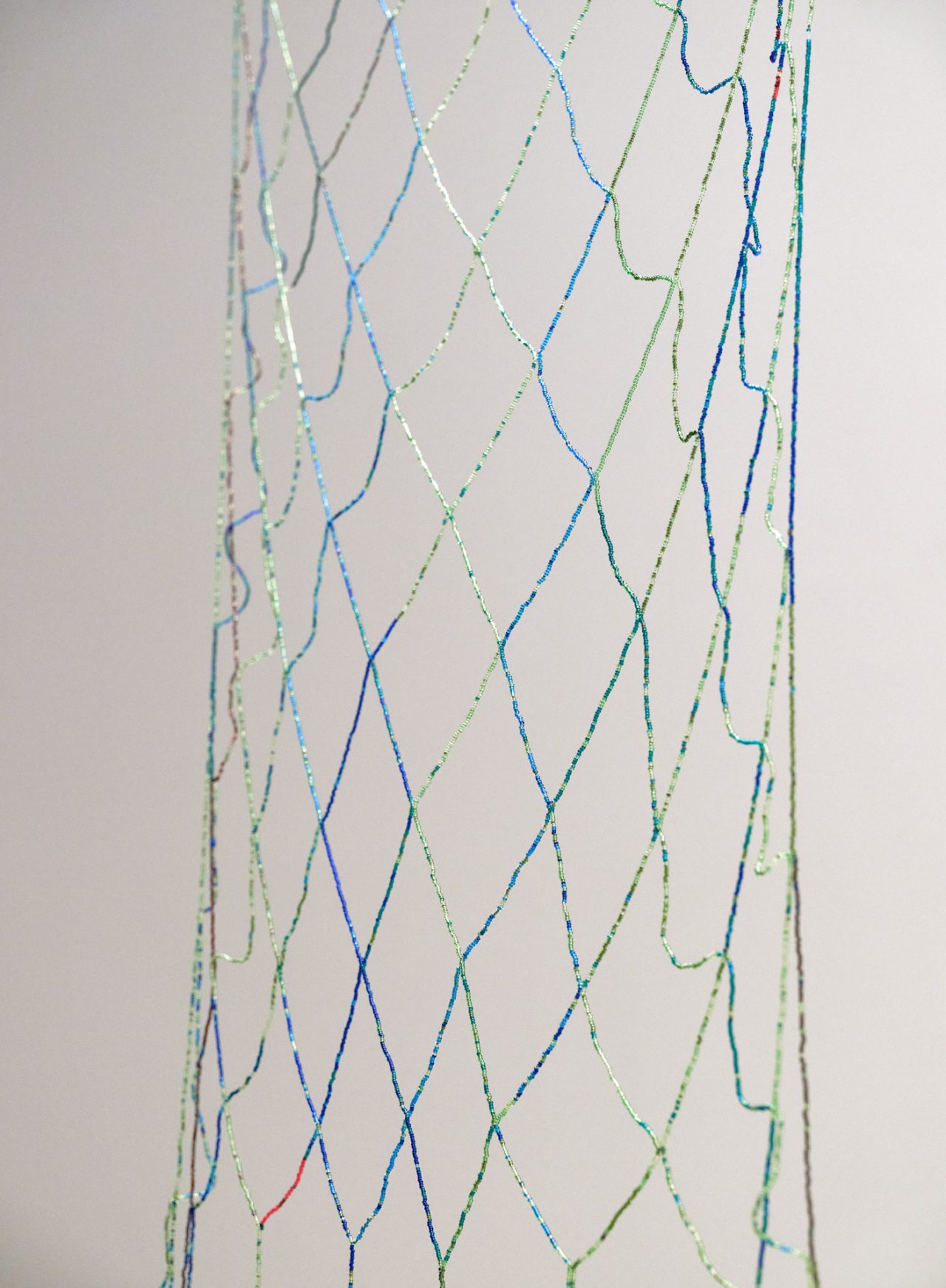
through, in between oceans part 2 by Camille Georgeson-Usher is a beaded installation, completed during the isolation of the Spring 2020 pandemic. The artist worked from home in Toronto, a departure from her intention to spend several months on Galiano Island, BC, where she was raised.
[more] -
Event
8 Sep 2020
Soundings: Greg Staats
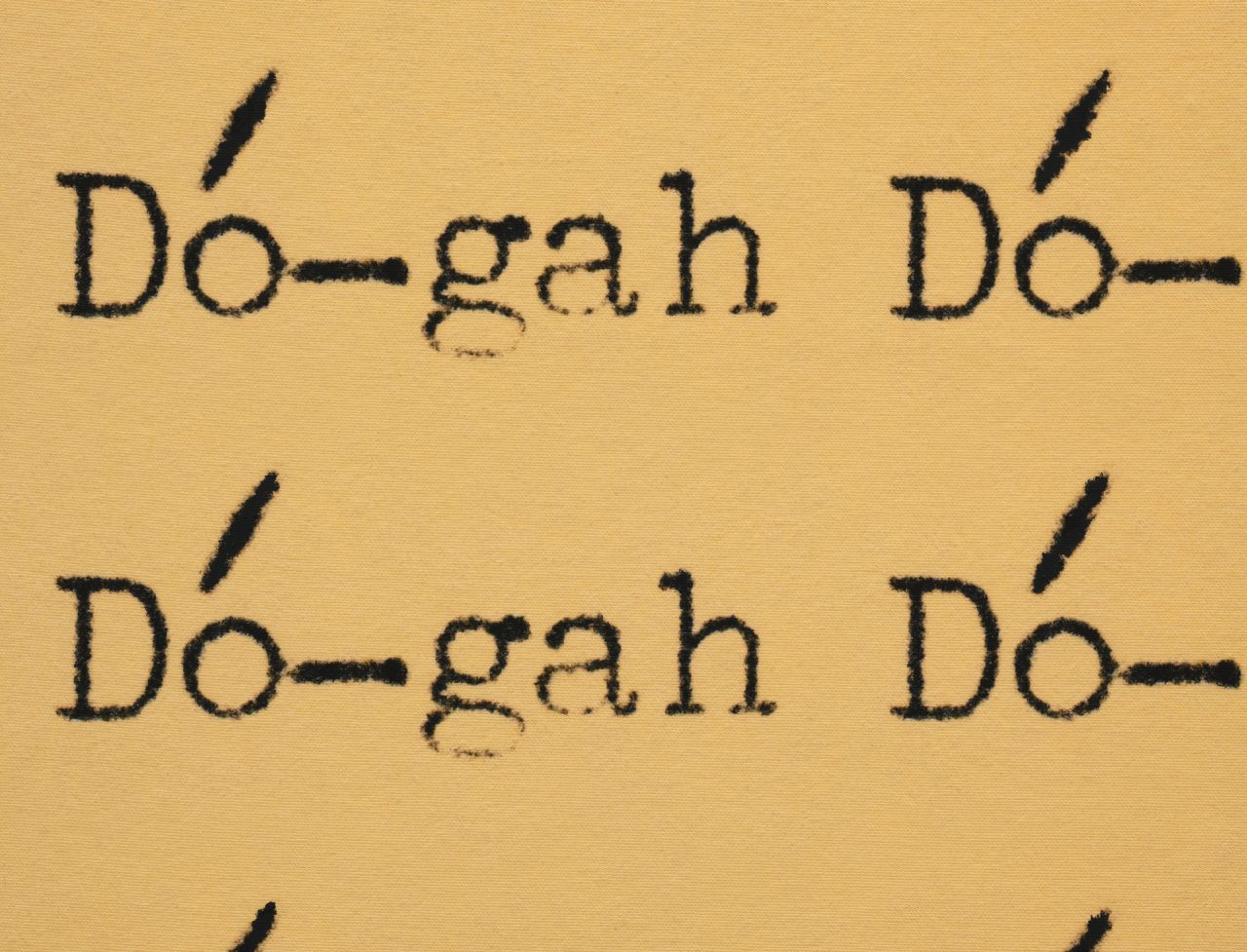 [more]
[more] -
Event
Wednesday 21 Oct 2020 at 3 pm
Wednesday 28 Oct 2020 at 3 pm
Wednesday 25 Nov 2020 at 2 pm
Wednesday 2 Dec 2020 at 3 pm
Sunday 6 Dec 2020 at 3 pm
Soundings: Olivia Whetung and the Ladner Clock Tower Carillon
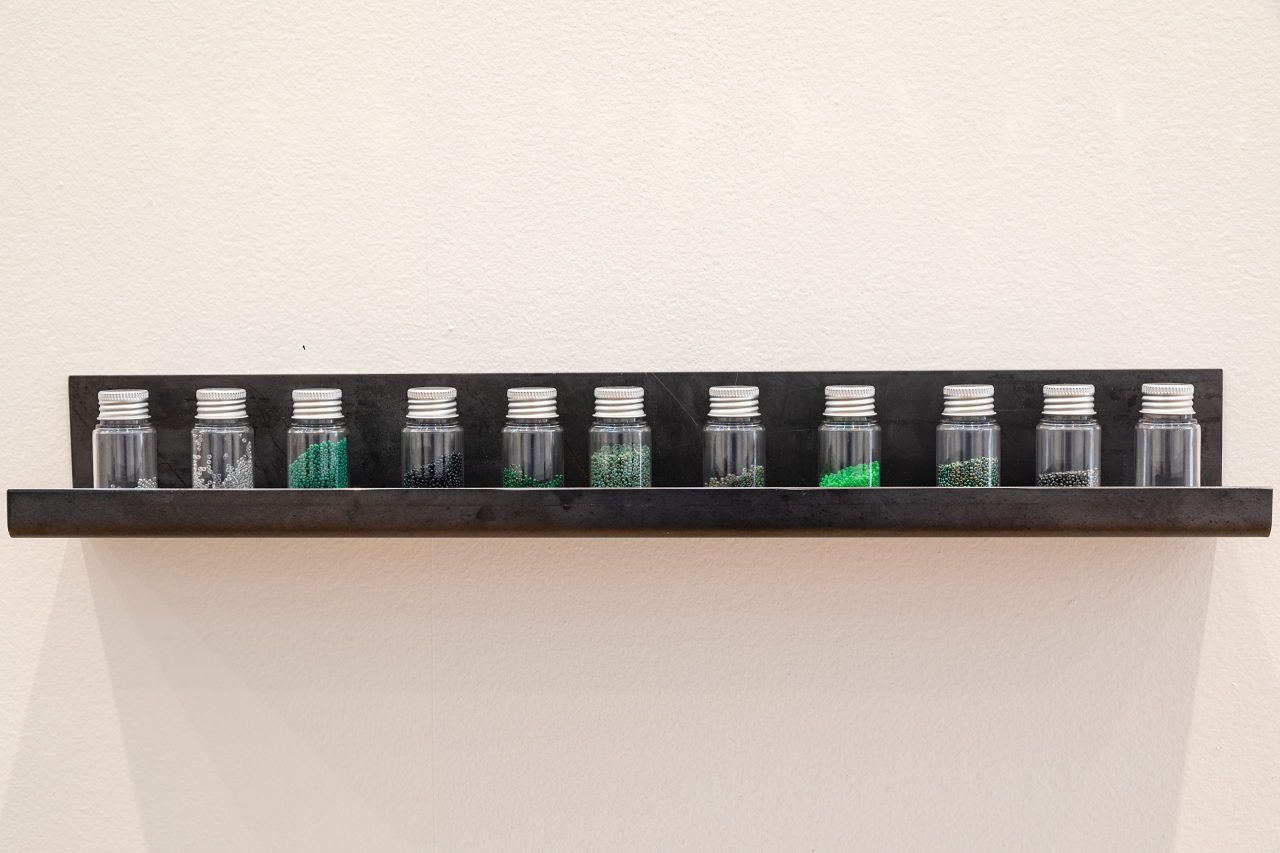
Whetung invites gallery visitors to pour different coloured beads from individual small jars into one large vessel, creating a layering of sounds as each bead joins the growing pile. Once the container is filled, the artist turns the amalgam of beads into an entirely new piece – a rectangular beadwork unique to the Belkin’s iteration of the exhibition.
[more] -
Event
8 Oct 2020 at 4 pm
Soundings: Raven Chacon and Symphonic Wind Ensemble
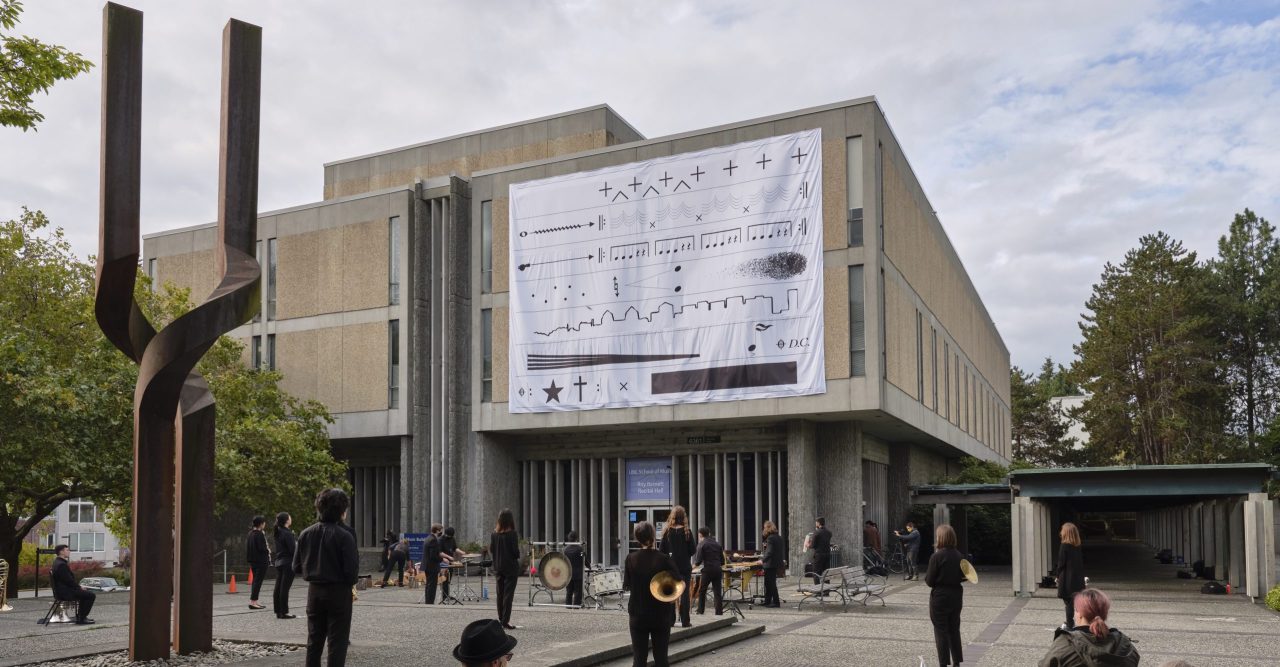
Around the corner from the Belkin Gallery, Raven Chacon's score American Ledger (No. 1) hangs on the exterior of the Music Building at 6361 Memorial Road, UBC. The score incorporates a traditional musical score with Navajo iconography and is to be performed by "many players with sustaining and percussive instruments, voices, coins, axe and wood, a police whistle and the striking of a match."
[more] -
Event
Monday 30 Nov 2020 at 4:30 pm
Soundings: Tania Willard and Melody Courage

Surrounded/Surrounding includes a wood-burning fire bowl, etched leather camp stools and a life-sized rendering of the artist’s wood pile in a graphic score. Written on the split logs and the spaces between them are references to the breathing, beating labour that creates what a fire needs, as well as the trees, sun, sky and ground that surrounds and creates all else.
[more] -
Event
Dec 2020
Soundings: UBC Contemporary Players Respond
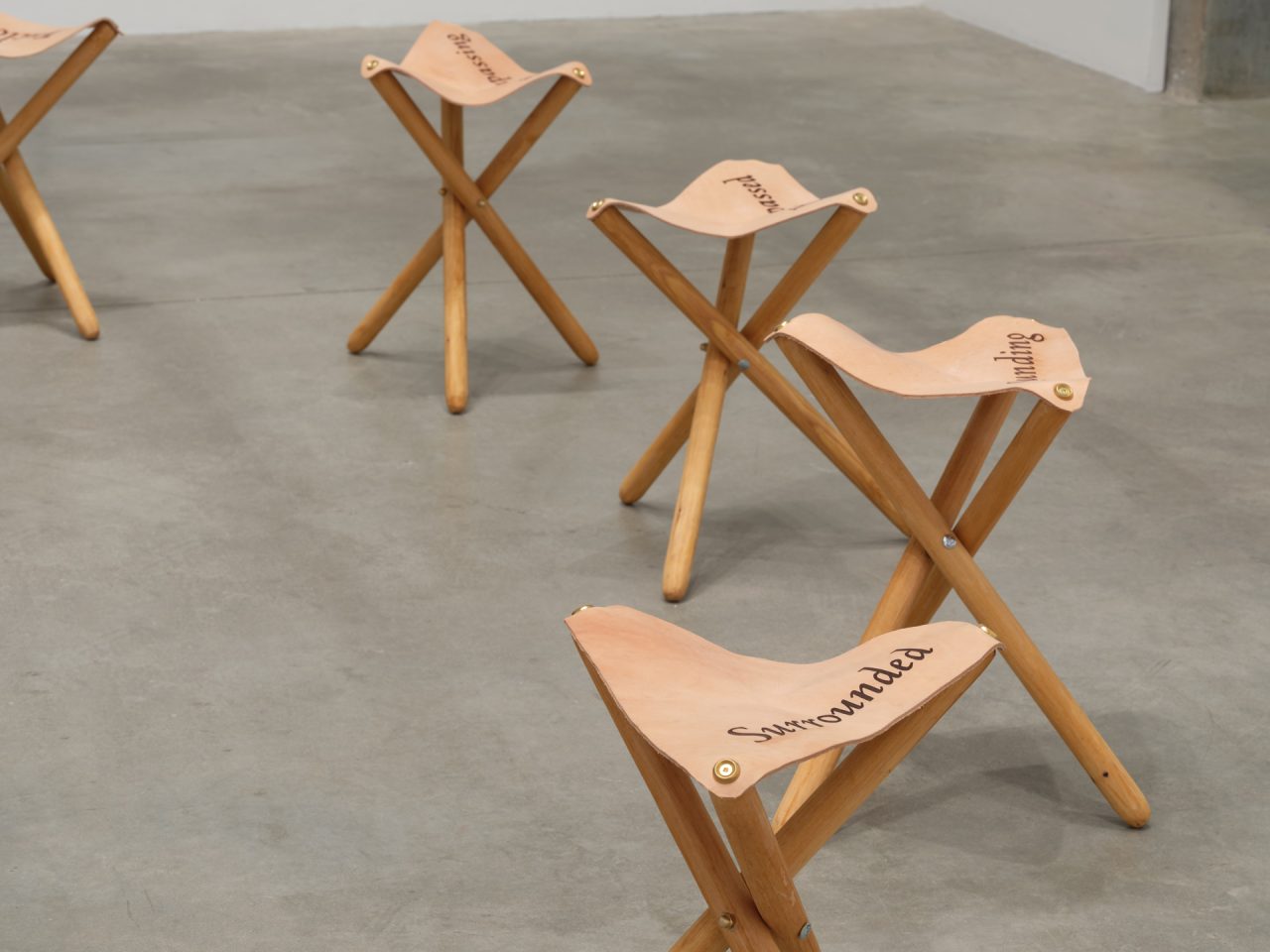
In lieu of a public concert at the Belkin as has occurred in recent years, musicians from UBC Contemporary Players chose a work by a Canadian composer to perform in an empty gallery, responding to the works of Soundings: An Exhibition in Five Parts. Videos of these performances are shared here for reference, research, and enjoyment in perpetuity. Soundings asks how a score can be a call and a tool for decolonization. The exhibition's corresponding investigations take at their centre questions of embodiment and subjectivity, of calls and responses. What are the practical matters of embodied decolonization, and how can we practice them? How does embodiment facilitate unlearning, unknowing, and the visioning of Indigenous ontologies?
[more] -
News
10 Dec 2020
Soundings: Marking Time
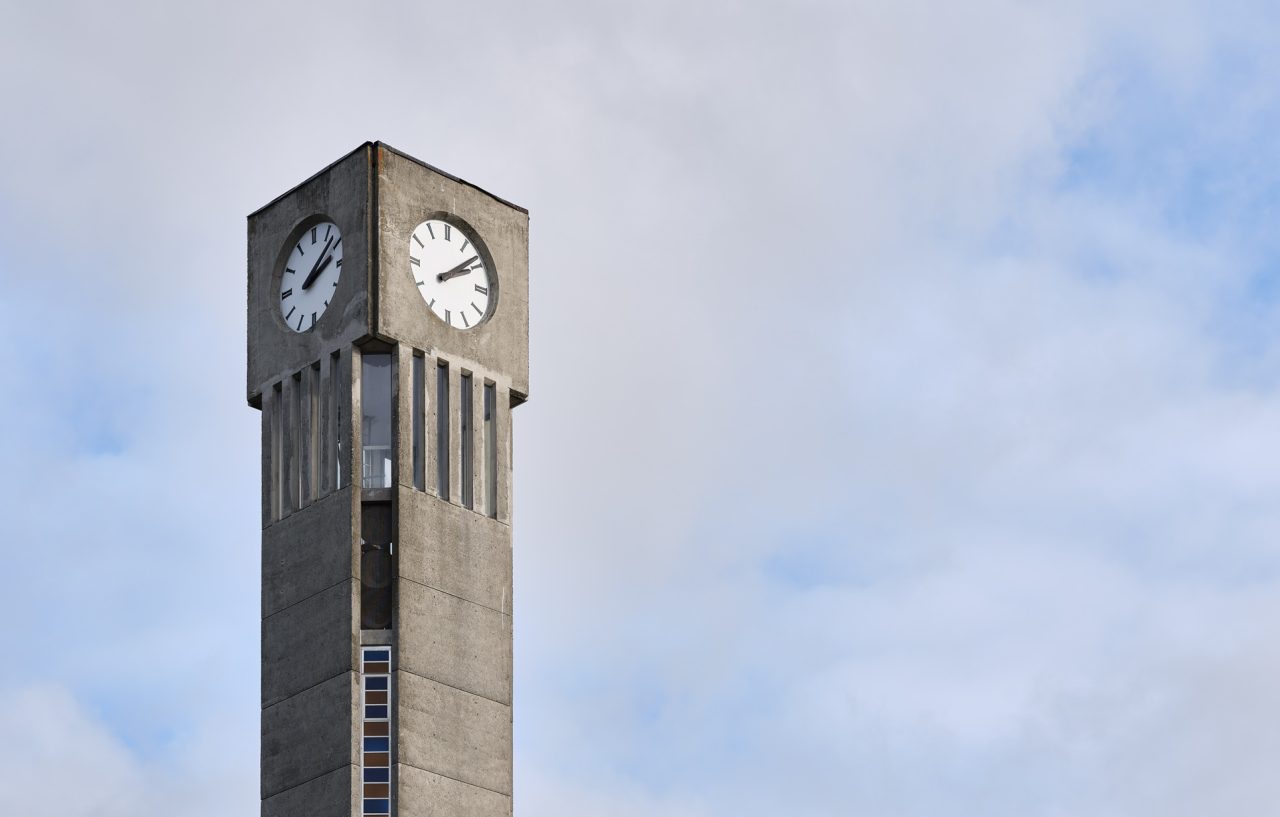 [more]
[more]